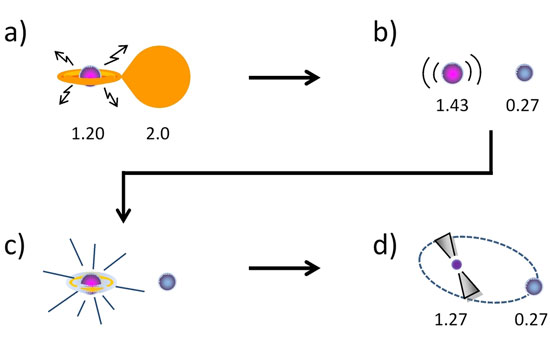| Dec 16, 2013 |
The manifold path to millisecond pulsars
|
|
(Nanowerk News) Two astronomers from Bonn have proposed a new path for the formation of a newly discovered class of millisecond pulsars with similar orbital periods and eccentricities. In the scenario of Paulo Freire and Thomas Tauris, a massive white dwarf star accretes matter and angular momentum from a normal companion star and grows beyond the critical Chandrasekhar mass limit. The new hypothesis makes several testable predictions about this recently discovered sub-class of millisecond pulsars ("Direct formation of millisecond pulsars from rotationally delayed accretion-induced collapse of massive white dwarfs"). If confirmed, it opens up new avenues of research into the physics of stars, in particular the momentum kicks and mass loss associated with accretion induced collapse of massive white dwarfs.
|
 |
|
The final path of close binary stellar evolution according to the new scenario: (a) An X-ray binary with an accreting white dwarf of initially 1.2 solar masses and a donor star of about 2.0 solar masses. (b) Although the white dwarf has accreted sufficient matter to grow beyond the critical Chandrasekhar mass limit, it does not collapse immediately into a neutron star after termination of the mass transfer because it is rotating very fast and is thus sustained by centrifugal forces. (c) Eventually, this massive white dwarf loses sufficient spin angular momentum to slow down and finally collapse directly into a millisecond radio pulsar in an eccentric orbit (d). The companion star is a low-mass helium white dwarf, the remnant of the original donor star. All masses shown are in solar masses. (© Paulo Freire & Thomas Tauris)
|
|
Neutron stars can spin very fast – with a record value of 716 rotations per second. Such extreme objects are known as millisecond pulsars. Ever since their first discovery in 1982, it has been thought that they are old dead neutron stars that are lucky enough to be in binary star system. As the companion evolves, it starts transferring matter onto the neutron star, spinning it up. This sort of system is known as an X-ray binary. Eventually the companion evolves into a white dwarf star, accretion stops and the neutron star becomes a millisecond pulsar, detectable through its radio pulsations. The orbits of these systems have very low eccentricities, meaning their orbits are extremely close to being perfect circles. This is a consequence of the tidal circularization that happens during the mass transfer stage. Such a scenario has been confirmed both in theoretical work and in the discovery of several systems in different stages of their evolution from X-ray binaries to millisecond pulsars.
|
|
However, recent discoveries like PSR J1946+3417 are hinting at the possibility of different formation paths to millisecond pulsars. This source is among 14 new pulsars recently discovered with the Effelsberg 100-m radio telescope. Spinning 315 times per second, this is clearly a millisecond pulsar; however, its orbital eccentricity is 4 orders of magnitude larger than other systems with a similar orbital period. Its companion mass is about 0.24 solar masses, most likely a helium white dwarf. Interestingly enough, at about the same time, two systems with similar parameters were discovered using the Arecibo 305 m radio telescope.
|
|
It is quite possible that these binary systems started their evolution as triple systems which became dynamically unstable, as in the case of PSR J1903+0327, the first millisecond pulsar with an eccentric orbit. However, this process generates a wide variety of orbital periods, eccentricities and companion masses, quite unlike the three new discoveries, which are in everything very similar.
|
|
The new hypothesis includes the collapse of a massive white dwarf after accretion has terminated. It explains not only the similarity of eccentricities and companion masses, but also their values. "I was surprised when we looked at the calculated orbital periods and eccentricities predicted by our model", says Thomas Tauris, affiliated with both, Argelander-Institut für Astronomie & Max-Planck-Institut für Radioastronomie (MPIfR) in Bonn. "It gives an exact match with the observations! Thus I knew then we were on to something, although small number statistics could still be at work."
|
|
The new theory builds on previous extensive computational work lead by Tauris. It makes a prediction for the new type of systems: they should have orbital periods between 10 and 60 days, but with a concentration towards the middle of that range, almost exactly as observed for the new systems.
|
|
"Our new approach is very elegant", says the lead author, Paulo Freire from MPIfR. "But whether Nature is really making millisecond pulsars this way is not known yet.''
|
|
For the next few years, the pulsar team at the Fundamental Physics In Radio Astronomy Group at MPIfR will be involved in testing the predictions of this scenario, particularly by doing optical follow-up studies and by making precise mass measurements of the pulsars and their companions, a key feature of this study. They will also attempt to find more of these pulsar systems using the Effelsberg radio telescope.
|
|
"The neat thing is that if the theory passes these tests, it will allow us to learn much more about the kicks and mass loss associated with accretion induced supernovae, and even about the interiors of neutron stars. It might thus be an extremely useful piece of understanding", concludes Paulo Freire.
|

